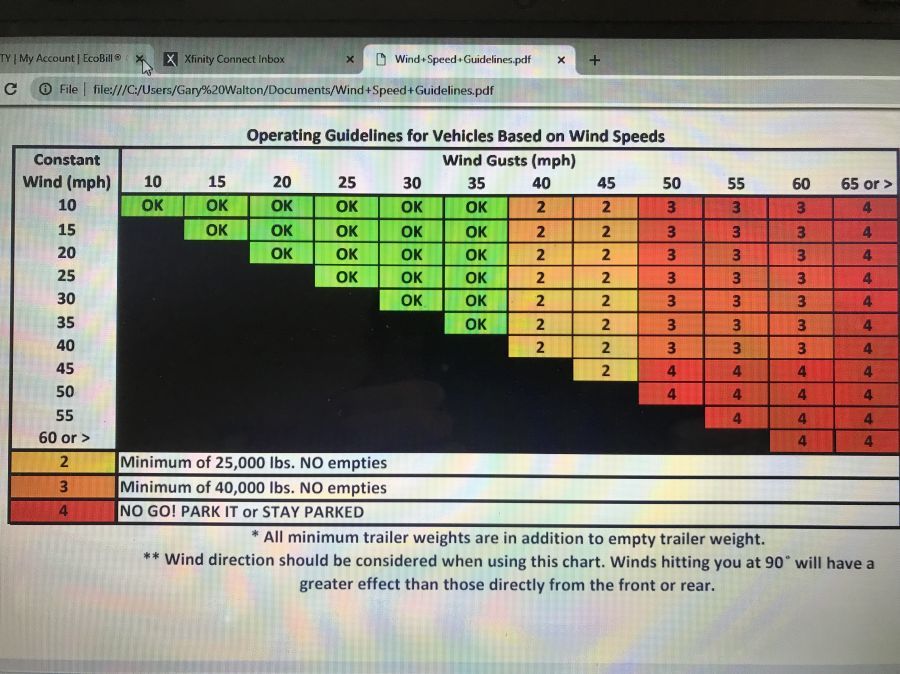Wind Speed Chart
Topic 24040 | Page 3

I second Bruce’s question. I’m a new driver and I’m taking a load from IA to TX basically through the storm that’s coming across that area today. Weather app calls for 20-30mph wind with gust between 40-55mph pretty much sustained for the next 24-36 hours. The chart helps and I have a full load, I guess I’m just looking for how experienced drivers feel about those wind speeds in general.
HOS:
Hours Of Service
HOS refers to the logbook hours of service regulations.
Ryan inquires...
I second Bruce’s question. I’m a new driver and I’m taking a load from IA to TX basically through the storm that’s coming across that area today. Weather app calls for 20-30mph wind with gust between 40-55mph pretty much sustained for the next 24-36 hours. The chart helps and I have a full load, I guess I’m just looking for how experienced drivers feel about those wind speeds in general.
The chart is self-explanatory and Swift guidance/policy. There is some discretion, but for me if sustained wind speed is 40mph with higher gusts and I’m empty, I’ll shut down. There have been several times dispatch was suspended at the DC until sustained wind speeds dropped to safer levels.
If your “full load” is close to or above 40,000 pounds, I’d run with it, but exercising extreme caution. Check to see what direction the wind is coming from. Cross winds are the most dangerous type to deal with. Drop your speed if necessary and firmly grip the wheel with both hands. If you are unsure, uncomfortable stop until the storms pass. No load is worth the risk of “laying it down”.
Be careful.
HOS:
Hours Of Service
HOS refers to the logbook hours of service regulations.
Bumping this for Rob D...
I just downloaded this from my driver portal.
G-Town,
Thanks.
I had saved this, along with your kingpin chart, the first time I saw it.
Definitely will have this in the truck.
Drove through Wyoming twice last week both days they had wind warnings. Both times they said the winds were 40 plus on the signs and I was pulling around 40,000 lb. I was buffeted all over the road. I did see them pulling one truck out of the ditch. Didn't look like he turned over but he was in the median. Needless to say both trips my shoulders were killing me after I got out of the area..
Sorry to dig up old thread, but exactly same conditions. 40k load. 15 mph winds, but 40mph gusts. Trailer doesn't move but the cab does. Lots of overthinking and worrying on my part. First experience with significant winds. Gut says it's fine, brain says I'm going to randomly flip over every gust.
Over The Road:
Over The Road
OTR driving normally means you'll be hauling freight to various customers throughout your company's hauling region. It often entails being gone from home for two to three weeks at a time.
TWIC:
Transportation Worker Identification Credential
Truck drivers who regularly pick up from or deliver to the shipping ports will often be required to carry a TWIC card.
Your TWIC is a tamper-resistant biometric card which acts as both your identification in secure areas, as well as an indicator of you having passed the necessary security clearance. TWIC cards are valid for five years. The issuance of TWIC cards is overseen by the Transportation Security Administration and the Department of Homeland Security.

Thank you for this. I'm sitting with an empty trailer wishing the wind would die down. I had a load I really wanted, but the sustained winds were 22 with gusts up to 40. I've done a heavily loaded trailer with those conditions. Had to slow down to 50 to feel safe handling it. But never tried it with an empty.
I have less than 6mo experience. I'd like to find out what I can and can't handle, but I don't think these conditions are a good starting place to find out.
"No load is worth the risk of “laying it down”."
Thank you, I needed to hear that. As badly as I wanted that load, I know this is true.
I'm thinking of trying when it gets down to 25. I'd love to hear what more experienced drivers think.
HOS:
Hours Of Service
HOS refers to the logbook hours of service regulations.Adding to my student notes ✅
Thanks G-Town!! 🙏🏻
The chart is a useful tool but blowing over isn't the only wind hazard. You can be driving down I-80 with some ice on the road when suddenly there's a wind gust. Driving on dry pavement you would be fine but you're on ice so the force of the wind rotates your truck on the road surface. If you were looking at your truck from above it would look like clock hands at 6:00 and a second later it would look like 8:10 WHILE YOU'RE DRIVING AT 55 MPH! Go ahead - ask he me how I know...
If you find yourself in this position:
1. Immediately take your foot off the gas. Tap the brakes if you need to disengage the cruise control. You'll be tempted to slam on your brakes because your truck will be headed off-road - DON'T - you don't have enough room to stop the truck and it will make it more difficult to recover control.
2. Establish control of the truck. GRADUALLY steer your truck back on the road. You may need to try more than once to get traction on your steers. Don't try to immediately get back in your lane - turning a hard 45 degrees is a good way to roll your truck or at least get your trailer tires airborne (which can shift your load and roll your truck anyway).
3. Return to your lane slow and easy. If you panic and oversteer you can find yourself driving off the other side of the road
4. Once you recover - SLOW DOWN. The slower you go the more traction your tires will have. Depending on how heavy your load is, how bad the wind is and where you're at (Laramie to Rawlins is usually the worst) you can decide to try again 10-15 mph slower or find a place to camp out until weather conditions improve.
If you're an inexperienced driver PAY ATTENTION TO WHAT THE OTHER DRIVERS ARE DOING! If you're the only truck on the road in a snowstorm and you see a dozen trucks parked on an exit ramp that's a clue that you should think about finding a place to shut down.
OWI:
Operating While Intoxicated

The chart is a useful tool but blowing over isn't the only wind hazard. You can be driving down I-80 with some ice on the road when suddenly there's a wind gust. Driving on dry pavement you would be fine but you're on ice so the force of the wind rotates your truck on the road surface. If you were looking at your truck from above it would look like clock hands at 6:00 and a second later it would look like 8:10 WHILE YOU'RE DRIVING AT 55 MPH! Go ahead - ask he me how I know...
If you find yourself in this position:
1. Immediately take your foot off the gas. Tap the brakes if you need to disengage the cruise control. You'll be tempted to slam on your brakes because your truck will be headed off-road - DON'T - you don't have enough room to stop the truck and it will make it more difficult to recover control.
2. Establish control of the truck. GRADUALLY steer your truck back on the road. You may need to try more than once to get traction on your steers. Don't try to immediately get back in your lane - turning a hard 45 degrees is a good way to roll your truck or at least get your trailer tires airborne (which can shift your load and roll your truck anyway).
3. Return to your lane slow and easy. If you panic and oversteer you can find yourself driving off the other side of the road
4. Once you recover - SLOW DOWN. The slower you go the more traction your tires will have. Depending on how heavy your load is, how bad the wind is and where you're at (Laramie to Rawlins is usually the worst) you can decide to try again 10-15 mph slower or find a place to camp out until weather conditions improve.
If you're an inexperienced driver PAY ATTENTION TO WHAT THE OTHER DRIVERS ARE DOING! If you're the only truck on the road in a snowstorm and you see a dozen trucks parked on an exit ramp that's a clue that you should think about finding a place to shut down.
Thank you, that's very helpful! Having spent my entire life in Mississippi, I've not had much experience on snow and ice. And what little I have had was in this truck. 😏
OWI:
Operating While Intoxicated
New Reply:
New! Check out our help videos for a better understanding of our forum features

















Preview:
This topic has the following tags:
Adverse Conditions Advice For New Truck Drivers Dealing With The Weather Truck Driver Safety








 TT On Facebook
TT On Facebook
G-Town
Thanks for the chart. Where can we go to print it out? Also can you and the other experienced drivers give us new drivers some further advice about driving in high winds? Do you use this chart to determine when to get off the road?